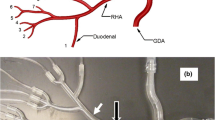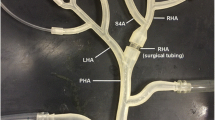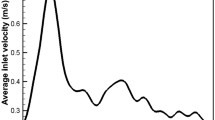Abstract
To reach a predictive understanding of how particles travel through bifurcating vessels is of paramount importance in many biomedical settings, including embolization, thromboembolism, and drug delivery. Here we utilize an in vitro model in which solid particles are injected through a rigid vessel that symmetrically bifurcates in successive branching generations. The geometric proportion and fluid dynamics parameters are relevant to the liver embolization. The volumetric flow field is reconstructed via phase-contrast magnetic resonance imaging, from which the particle trajectories are calculated for a range of size and density using the particle equation of motion. The method is validated by directly tracking the injected particles via optical imaging. The results indicate that, opposite to the common assumption, the particles distribution is fundamentally different from the volumetric flow partition. In fact, the amount of delivered particles vary substantially between adjacent branches even when the flow is uniformly distributed. This is not due to the inertia of the particles, nor to gravity. The particle distribution is rather rooted in their different pathways, which in turn are linked to their release origin along the main vessel cross-section. Therefore, the tree geometry and the associated flow streamlines are the prime determinant of the particle fate, while local changes of volumetric flow rate to selected branches do not generally produce proportional changes of particle delivery.









Similar content being viewed by others
References
Amili, O., R. MacIver, and F. Coletti. MRI-based flow field and Lagrangian particle tracking from a left ventricular assist device. ASME J. Biomech. Eng. 2019. In press.
Amili, O., D. Schiavazzi, S. Moen, B. Jagadeesan, P.-F. Van De Moortele, and F. Coletti. Hemodynamics in a giant intracranial aneurysm characterized by in vitro 4D flow MRI. PLoS ONE 13:e0188323, 2018.
Aramburu, J., R. Antón, A. Rivas, J. Ramos, B. Sangro, and J. Bilbao. Computational assessment of the effects of the catheter type on particle-hemodynamics during liver radioembolization. J. Biomech. 49:3705–3713, 2016.
Aramburu, J., R. Antón, A. Rivas, J. Ramos, B. Sangro, and J. Bilbao. The role of angled-tip microcatheter and microsphere injection velocity in liver radioembolization: A computational particle-hemodynamics study. Int. J. Numer. Methods Biomed. Eng. 33:e2895, 2017.
Balachandar, S. A scaling analysis for point-particle approaches to turbulent multiphase flows. Int. J. Multiph. Flow 35:801–810, 2009.
Balachandar, S. and J. Eaton. Turbulent dispersed multiphase flow. Annu. Rev. Fluid Mech. 42:111–133, 2010.
Basciano, C., C. Kleinstreuer, A. Kennedy, W. Dezarn, and E. Childress. Computer modeling of controlled microsphere release and targeting in a representative hepatic artery system. Ann. Biomed. Eng. 38:1862–1879, 2010.
Born, S., M. Markl, M. Gutberlet, and G. Scheuermann. Illustrative visualization of cardiac and aortic blood flow from 4D MRI data. 2013, pp. 129–136.
Bray, F., J. Ferlay, I. Soerjomataram, R. Siegel, L. Torre, and A. Jemal. Global cancer statistics 2018: Globocan estimates of incidence and mortality worldwide for 36 cancers in 185 countries. CA Cancer J. Clin. 68:394–424, 2018.
Bushi, D., Y. Grad, S. Einav, O. Yodfat, B. Nishri, and D. Tanne. Hemodynamic evaluation of embolic trajectory in an arterial bifurcation: an in-vitro experimental model. Stroke 36:2696–2700, 2005.
Caine, M., M. McCafferty, S. McGhee, P. Garcia, W. Mullett, X. Zhang, M. Hill, M. Dreher, and A. Lewis. Impact of yttrium-90 microsphere density, flow dynamics, and administration technique on spatial distribution: analysis using an in vitro model. J. Vasc. Interv. Radiol. 28:260.e2–268.e2, 2017.
Carr, I., N. Nemoto, R. Schwartz, and S. Shadden. Size-dependent predilections of cardiogenic embolic transport. Am. J. Physiol. Heart Circ. Physiol. 305:H732–H739, 2013.
Cebral, J., M. Castro, S. Appanaboyina, C. Putman, D. Millan, and A. Frangi. Efficient pipeline for image-based patient-specific analysis of cerebral aneurysm hemodynamics: technique and sensitivity. IEEE Trans. Med. Imaging 24:457–467, 2005.
Chen, J. and X.-Y. Lu. Numerical investigation of the non-newtonian pulsatile blood flow in a bifurcation model with a non-planar branch. J. Biomech. 39:818–832, 2006.
Childress, E. and C. Kleinstreuer. Impact of fluid–structure interaction on direct tumor-targeting in a representative hepatic artery system. Ann. Biomed. Eng. 42:461–474, 2014.
Chung, E., J. Hague, M.-A. Chanrion, K. Ramnarine, E. Katsogridakis, and D. Evans. Embolus trajectory through a physical replica of the major cerebral arteries. Stroke 41:647–652, 2010.
Comer, J., C. Kleinstreuer, and Z. Zhang. Flow structures and particle deposition patterns in double-bifurcation airway models. Part 1. Air flow fields. J. Fluid Mech. 435:25–54, 2001.
Discetti, S. and F. Coletti. Volumetric velocimetry for fluid flows. Meas. Sci. Technol. 29:042001, 2018.
Elkins, C. and M. Alley. Magnetic resonance velocimetry: applications of magnetic resonance imaging in the measurement of fluid motion. Exp. Fluids 43:823–858, 2007.
Erturk, M., X. Wu, Y. Eryaman, P.-F. Van de Moortele, E. Auerbach, R. Lagore, L. DelaBarre, J. Vaughan, K. Uğurbil, G. Adriany, and G. Metzger. Toward imaging the body at 10.5 tesla. Magn. Reson. Med. 77:434–443, 2017.
Gijsen, F., F. Van De Vosse, and J. Janssen. The influence of the non-newtonian properties of blood on the flow in large arteries: steady flow in a carotid bifurcation model. J. Biomech. 32:601–608, 1999.
Glenny, R. Emergence of matched airway and vascular trees from fractal rules. J. Appl. Physiol. 110:1119–1129, 2011.
Golzarian, J., M. Sapoval, S. Kundu, D. Hunter, E. Brountzos, J.-F. Geschwind, T. Murphy, J. Spies, M. Wallace, T. de Baere, and J. Cardella. Guidelines for peripheral and visceral vascular embolization training. joint writing groups of the standards of practice committees for the society of interventional radiology (sir), cardiovascular and interventional radiological society of europe (cirse), and canadian interventional radiology association (cira). J. Vasc. Interv. Radiol. 21:436–441, 2010.
Gondret, P., M. Lance, and L. Petit. Bouncing motion of spherical particles in fluids. Phys. Fluids 14:643–652, 2002.
Guha, A. Transport and deposition of particles in turbulent and laminar flow. Annu. Rev. Fluid Mech. 40:311–341, 2008.
Hartke, J., M. Johnson, and M. Ghabril. The diagnosis and treatment of hepatocellular carcinoma. Semin. Diagn. Pathol. 34:153–159, 2017.
Hassan, Y., T. Blanchat, and C. Seeley Jr. PIV flow visualisation using particle tracking techniques. Meas. Sci. Technol. 3:633–642, 1992.
Hübner, G., N. Steudel, G. Kleber, C. Behrmann, E. Lotterer, and W. Fleig. Hepatic arterial blood flow velocities: assessment by transcutaneous and intravascular doppler sonography. J. Hepatol. 32:893–899, 2000.
Ishigami, K., Y. Zhang, S. Rayhill, D. Katz, and A. Stolpen. Does variant hepatic artery anatomy in a liver transplant recipient increase the risk of hepatic artery complications after transplantation? Am. J. Roentgenol. 183:1577–1584, 2004.
Jalal, S., A. Nemes, T. Van de Moortele, S. Schmitter, and F. Coletti. Three-dimensional inspiratory flow in a double bifurcation airway model. Exp. Fluids 57:148, 2016.
Jalal, S., T. Van De Moortele, A. Nemes, O. Amili, and F. Coletti. Three-dimensional steady and oscillatory flow in a double bifurcation airway model. Phys. Rev. Fluids 3:103101, 2018.
Kassab, G. Scaling laws of vascular trees: of form and function. Am. J. Physiol. Heart Circ. Physiol. 290:H894–H903, 2006.
Kennedy, A., C. Kleinstreuer, C. Basciano, and W. Dezarn. Computer modeling of yttrium-90-microsphere transport in the hepatic arterial tree to improve clinical outcomes. Int. J. Radiat. Oncol. Biol. Phys. 76:631–637, 2010.
Kleinstreuer, C., C. Basciano, E. Childress, and A. Kennedy. A new catheter for tumor targeting with radioactive microspheres in representative hepatic artery systems part i: Impact of catheter presence on local blood flow and microsphere delivery. J. Biomech. Eng. 134:51004, 2012.
Kleinstreuer, C., Z. Zhang, and J. Donohue. Targeted drug-aerosol delivery in the human respiratory system. Annu. Rev. Biomed. Eng. 10:195–220, 2008.
Ku, D. Blood flow in arteries. Annu. Rev. Fluid Mech. 29:399–434, 1997.
Lambert, A., P. O’Shaughnessy, M. Tawhai, E. Hoffman, and C.-L. Lin. Regional deposition of particles in an image-based airway model: large-eddy simulation and left-right lung ventilation asymmetry. Aerosol Sci. Technol. 45:11–25, 2011.
Lin, C.-L., M. Tawhai, and E. Hoffman. Multiscale image-based modeling and simulation of gas flow and particle transport in the human lungs. Wiley Interdiscipl. Rev. 5:643–655, 2013.
Markl, M., A. Frydrychowicz, S. Kozerke, M. Hope, and O. Wieben. 4D flow MRI. J. Magn. Reson. Imaging 36:1015–1036, 2012.
Mauroy, B., M. Filoche, J. Andrade, and B. Sapoval. Interplay between geometry and flow distribution in an airway tree. Phys. Rev. Lett. 90:4, 2003.
Maxey, M. and J. Riley. Equation of motion for a small rigid sphere in a nonuniform flow. Phys. Fluids 26:883–889, 1983.
Mukherjee, D., N. Jani, K. Selvaganesan, C. Weng, and S. Shadden. Computational assessment of the relation between embolism source and embolus distribution to the circle of willis for improved understanding of stroke etiology. J. Biomech. Eng. 138, 081008, 2016.
Mukherjee, D., J. Padilla, and S. Shadden. Numerical investigation of fluid-particle interactions for embolic stroke. Theor. Comput. Fluid Dyn. 30:23–39, 2016.
Ohmi, K. and H.-Y. Li. Particle-tracking velocimetry with new algorithms. Meas. Sci. Technol. 11:603–616, 2000.
Petersen, A., L. Baker, and F. Coletti. Experimental study of inertial particles clustering and settling in homogeneous turbulence. J. Fluid Mech. 864:925–970, 2019.
Richards, A., C. Kleinstreuer, A. Kennedy, E. Childress, and G. Buckner. Experimental microsphere targeting in a representative hepatic artery system. IEEE Trans. Biomed. Eng. 59:198–204, 2012.
Saffman, P. The lift on a small sphere in a slow shear flow. J. Fluid Mech. 22:385–400, 1965.
Schnell, S., S. Ansari, C. Wu, J. Garcia, I. Murphy, O. Rahman, A. Rahsepar, M. Aristova, J. Collins, J. Carr, and M. Markl. Accelerated dual-venc 4D flow MRI for neurovascular applications. J. Magn. Reson. Imaging 46: 102–114, 2017.
Segré, G. and A. Silberberg. Behaviour of macroscopic rigid spheres in poiseuille flow: Part 1. Determination of local concentration by statistical analysis of particle passages through crossed light beams. J. Fluid Mech. 14:115–135, 1962.
Segré, G. and A. Silberberg. Behaviour of macroscopic rigid spheres in poiseuille flow: Part 2. Experimental results and interpretation. J. Fluid Mech. 14:136–157, 1962.
Shadden, S. and A. Arzani. Lagrangian postprocessing of computational hemodynamics. Ann. Biomed. Eng. 43:41–58, 2014.
Taylor, K., P. Burns, J. Woodcock, and P. Wells. Blood flow in deep abdominal and pelvic vessels: ultrasonic pulsed-doppler analysis. Radiology 154:487–493, 1985.
Töger, J., M. Kanski, M. Carlsson, S. Kovács, G. Söderlind, H. Arheden, and E. Heiberg. Vortex ring formation in the left ventricle of the heart: analysis by 4D flow MRI and lagrangian coherent structures. Ann. Biomed. Eng. 40:2652–2662, 2012.
Van De Moortele, T., C. Wendt, and F. Coletti. Morphological and functional properties of the conducting human airways investigated by in vivo computed tomography and in vitro MRI. J. Appl. Physiol. 124:400–413, 2018.
Van Den Hoven, A., M. Lam, S. Jernigan, M. Van Den Bosch, and G. Buckner. Innovation in catheter design for intra-arterial liver cancer treatments results in favorable particle-fluid dynamics. J. Exp. Clin. Cancer Res. 34:74. 2015.
Acknowledgments
The authors would like to thank Sean Moen for his assistance in conducting MRI experiments and fruitful discussions on the matter. The authors acknowledge the Minnesota Supercomputing Institute (MSI) at the University of Minnesota for providing the computational resources required for this work. This work was partly supported by the University of Minnesota Department of Radiology.
Conflict of interest
The authors do not have conflicts of interest relevant to this manuscript.
Author information
Authors and Affiliations
Corresponding author
Additional information
Associate Editor Umberto Morbiducci oversaw the review of this article.
Publisher's Note
Springer Nature remains neutral with regard to jurisdictional claims in published maps and institutional affiliations.
Rights and permissions
About this article
Cite this article
Amili, O., Golzarian, J. & Coletti, F. In Vitro Study of Particle Transport in Successively Bifurcating Vessels. Ann Biomed Eng 47, 2271–2283 (2019). https://doi.org/10.1007/s10439-019-02293-2
Received:
Accepted:
Published:
Issue Date:
DOI: https://doi.org/10.1007/s10439-019-02293-2




